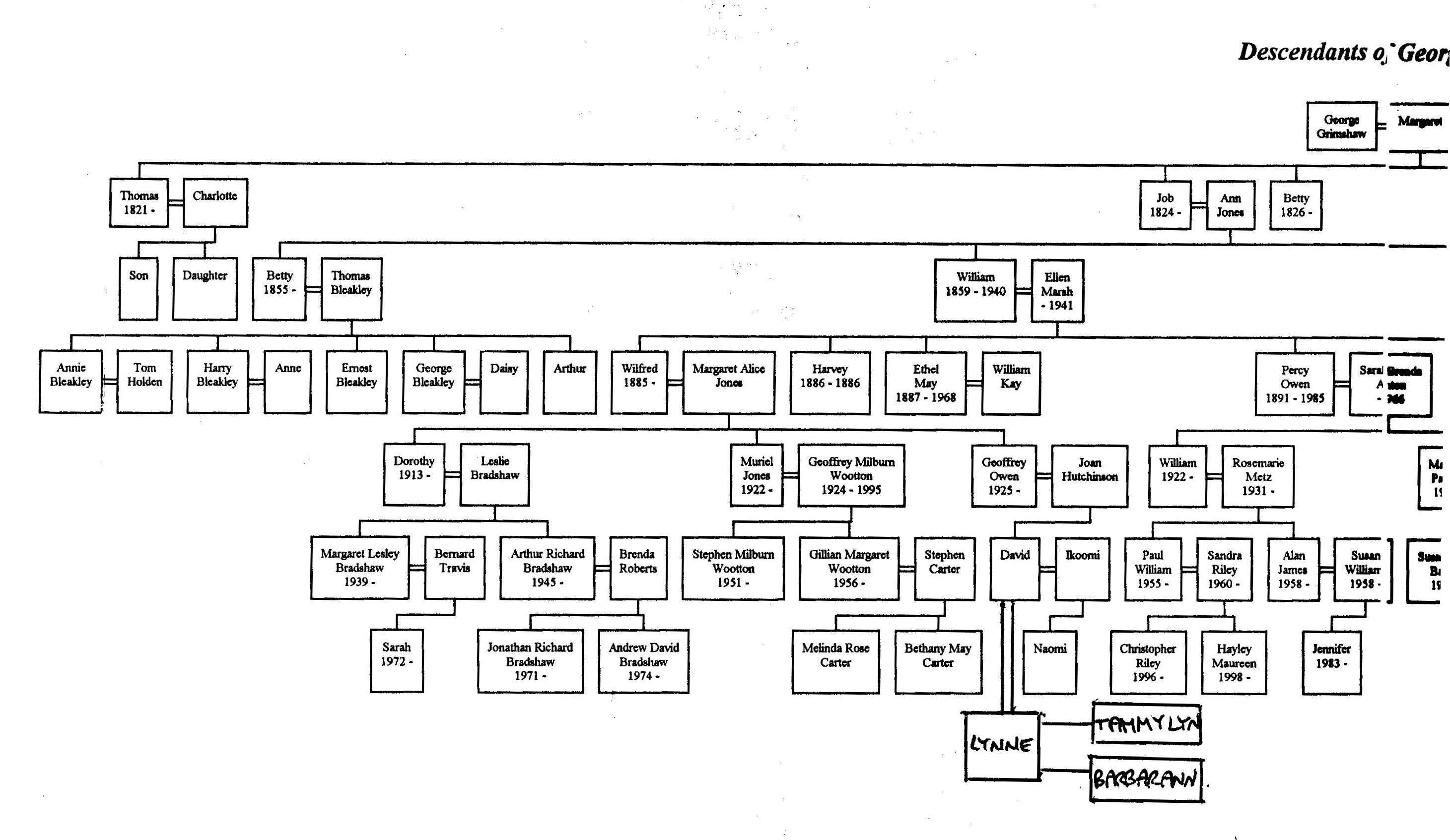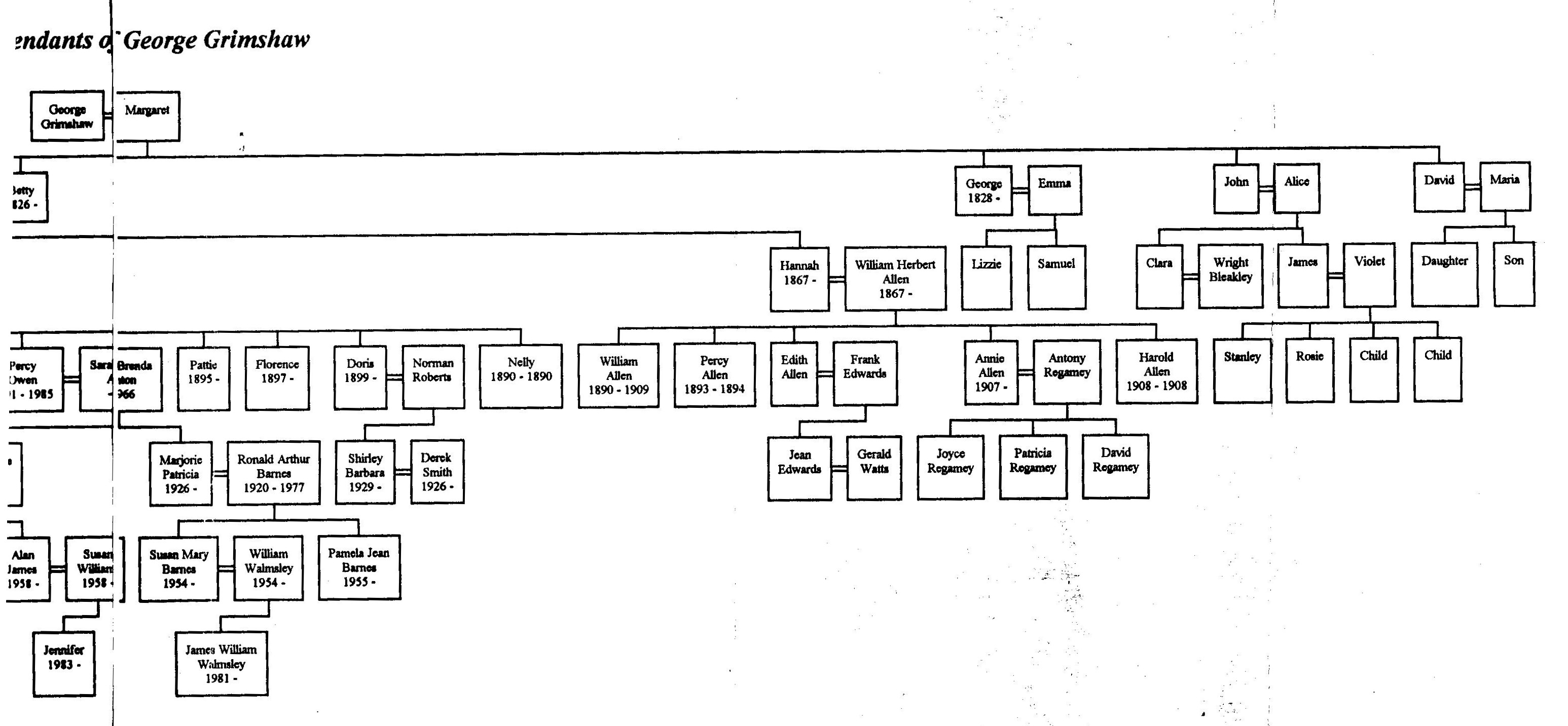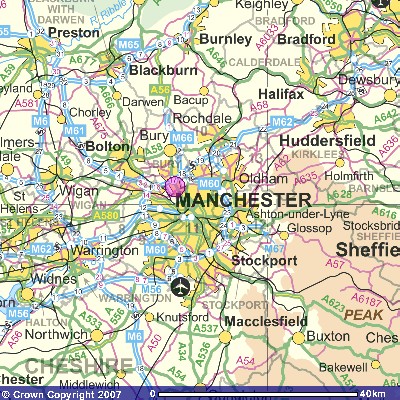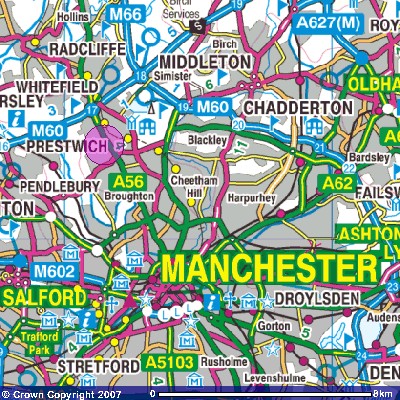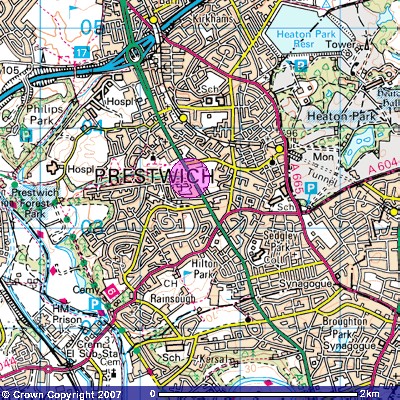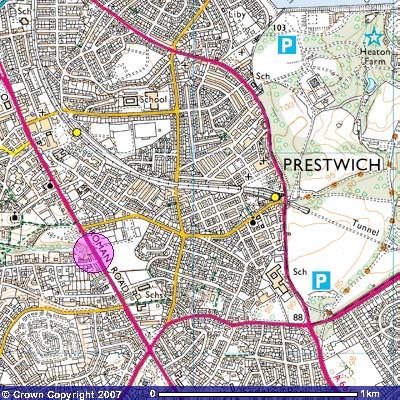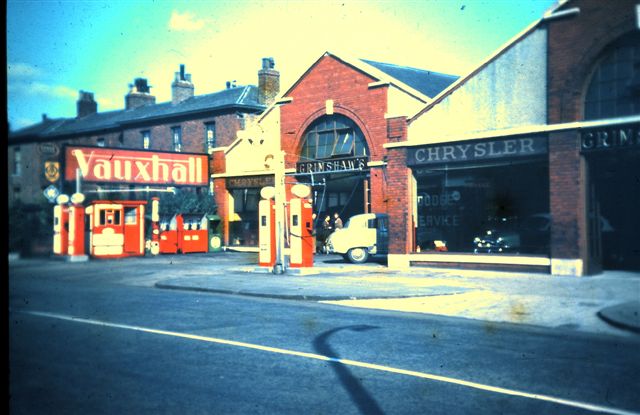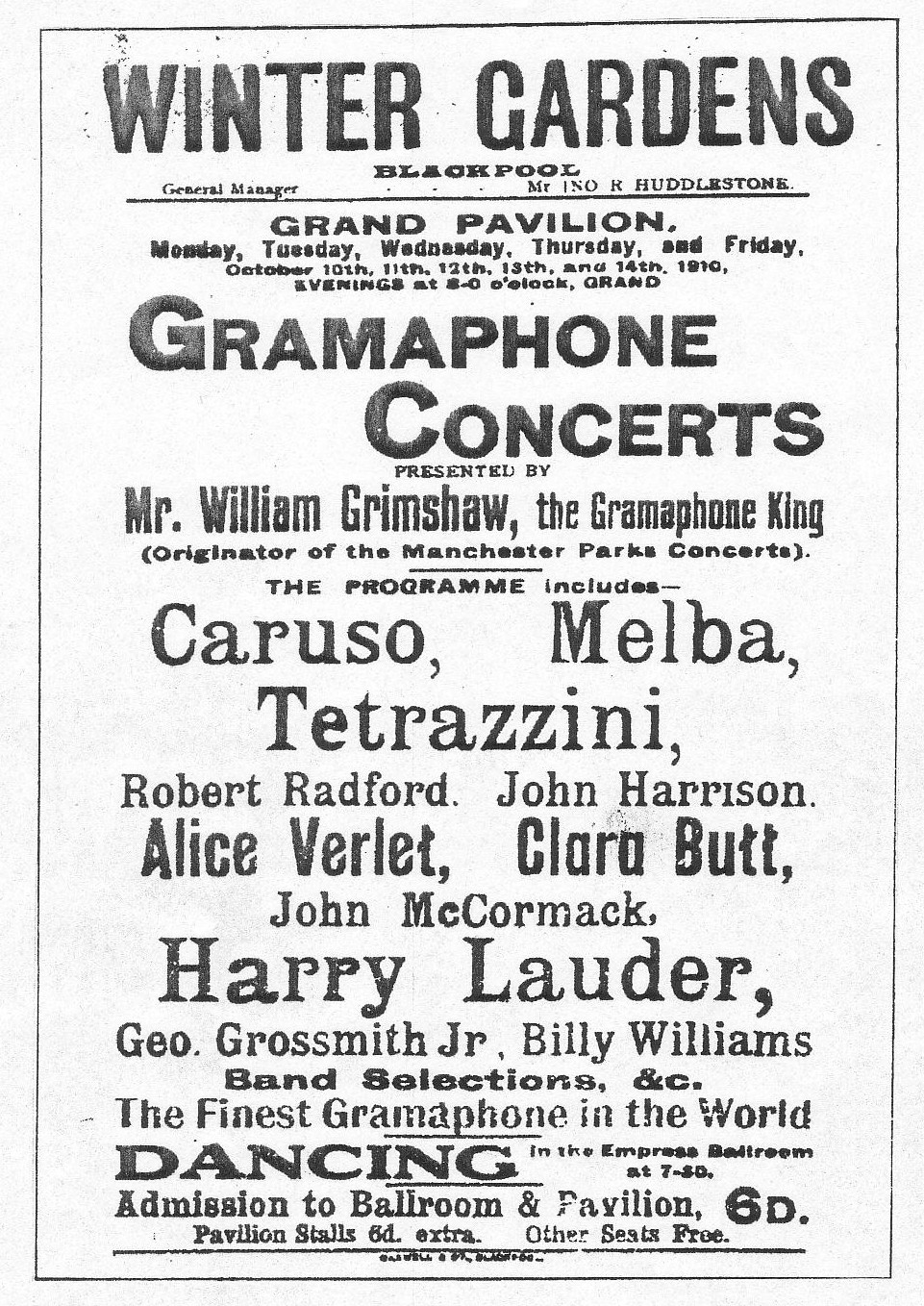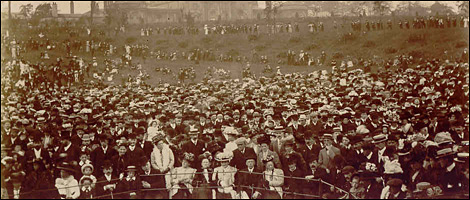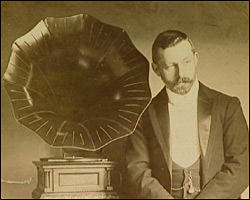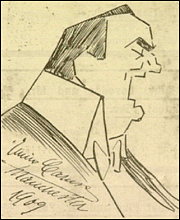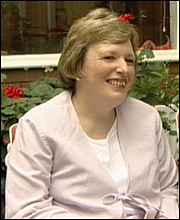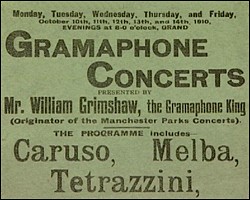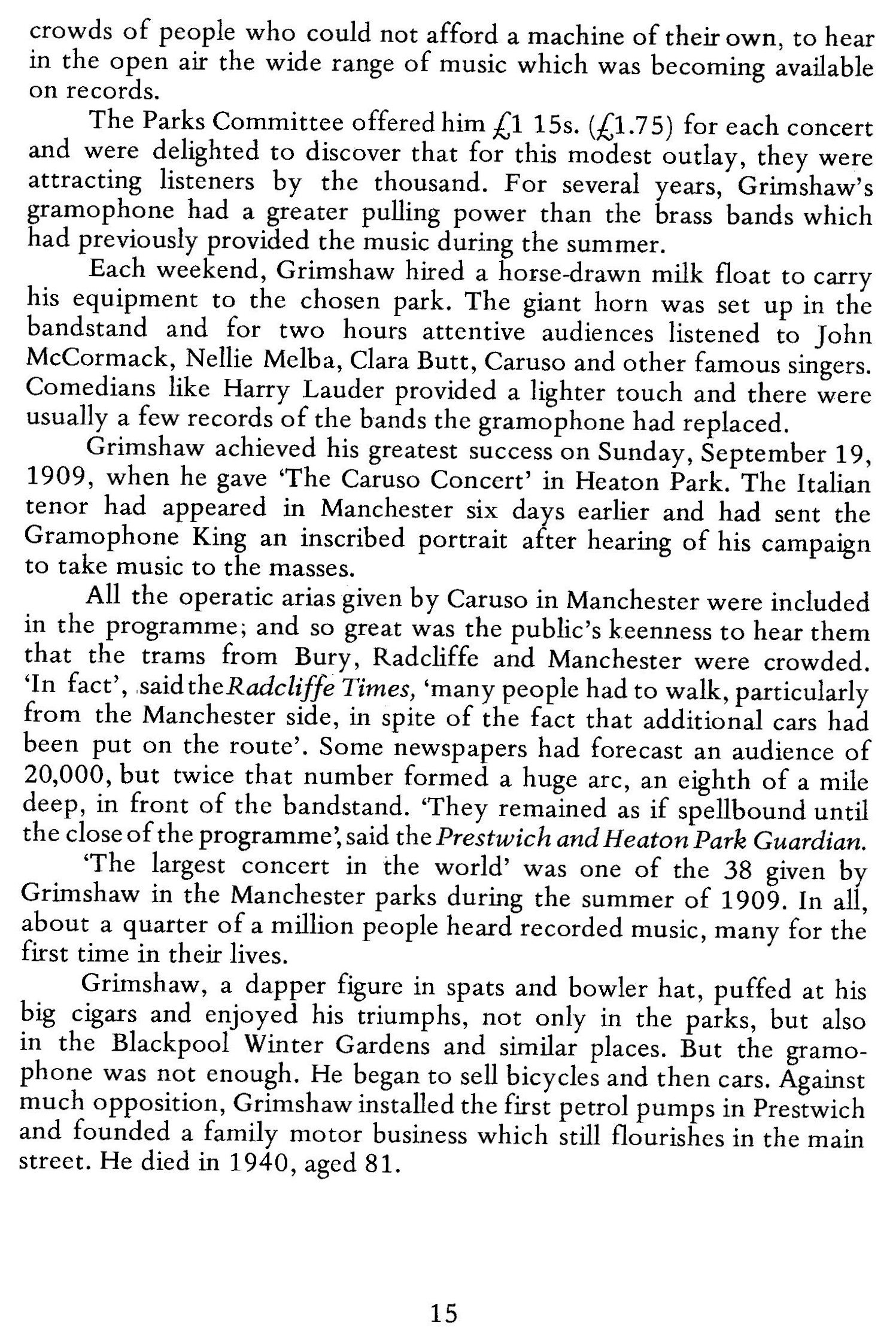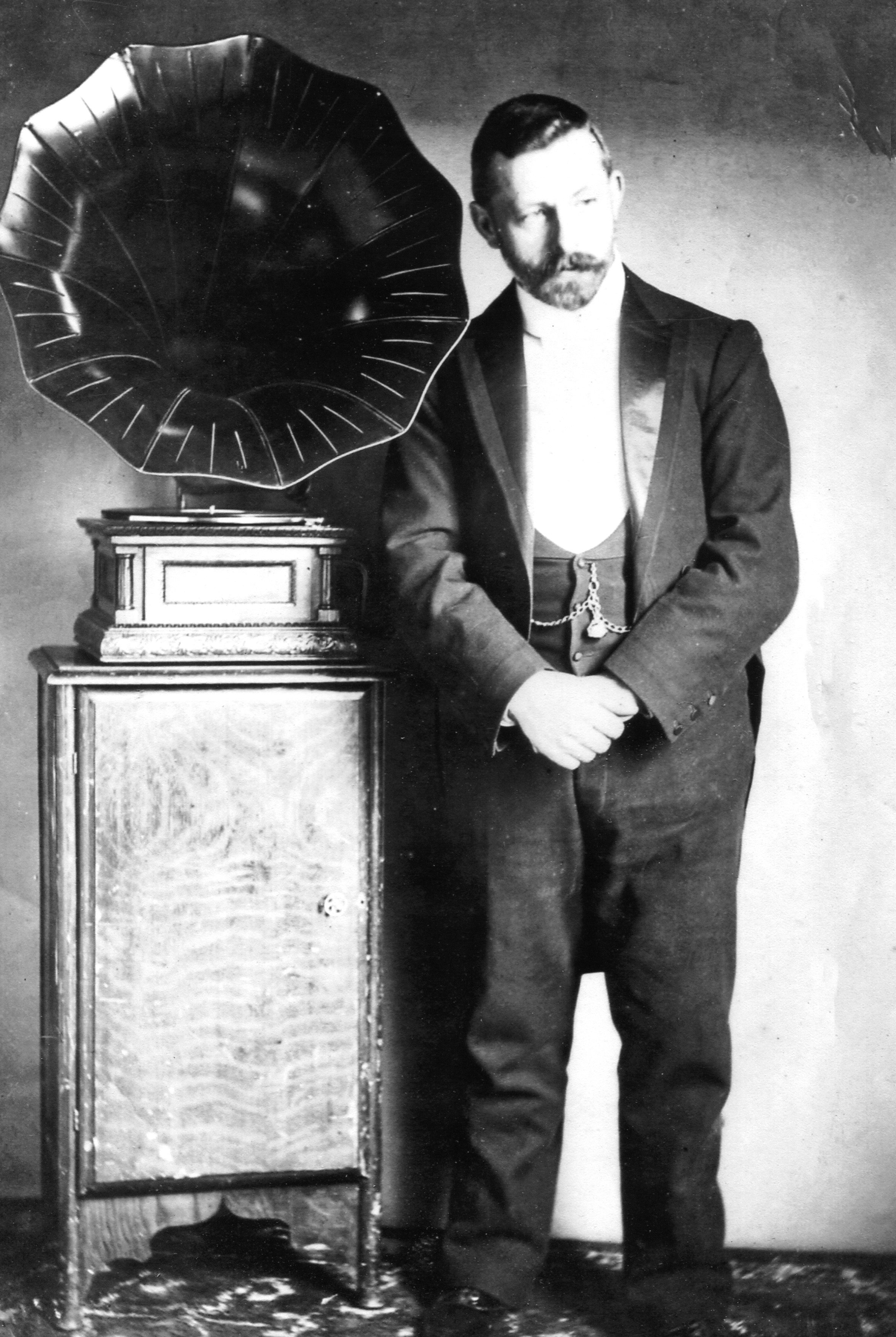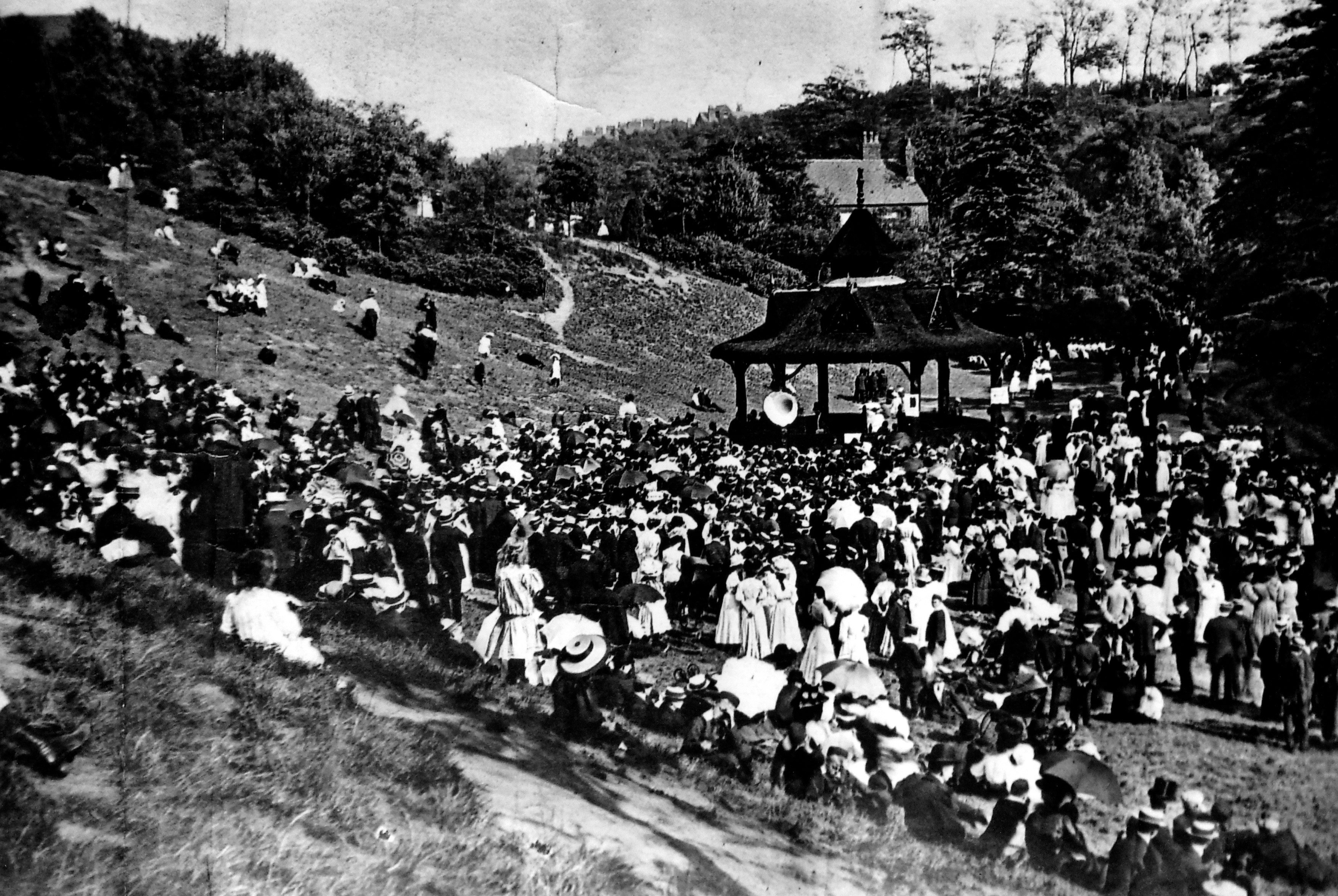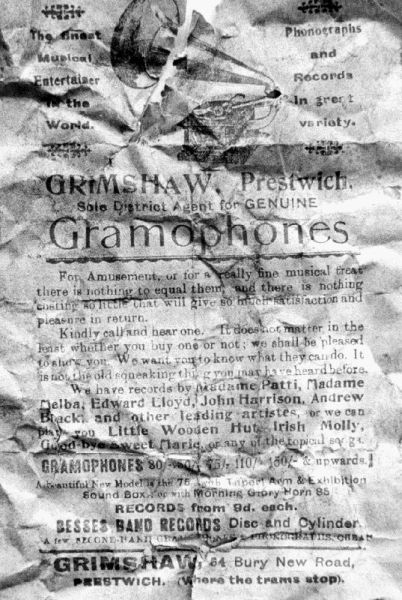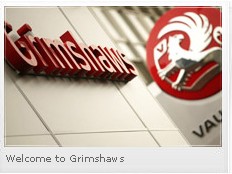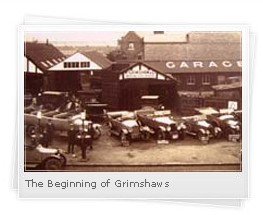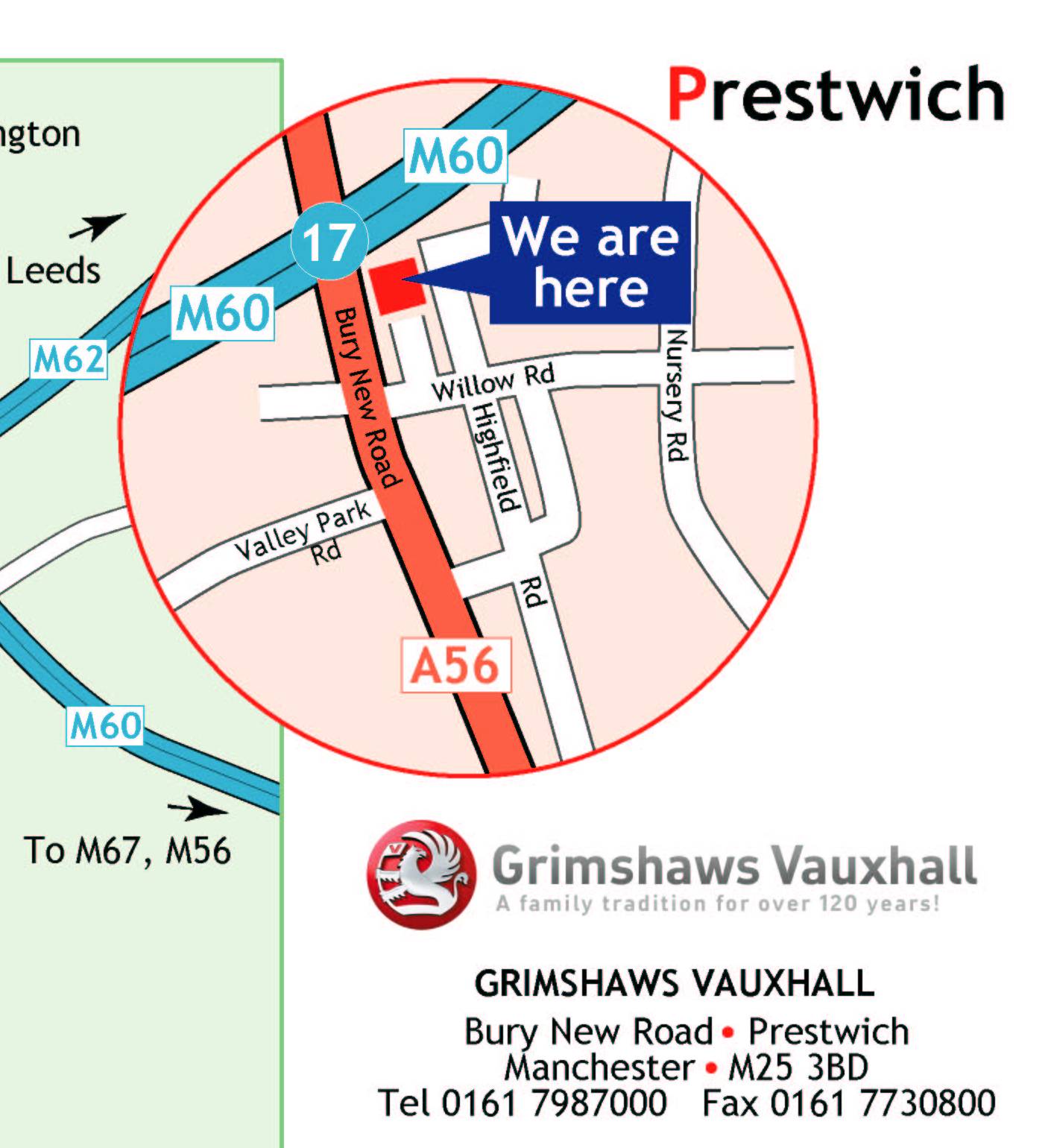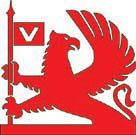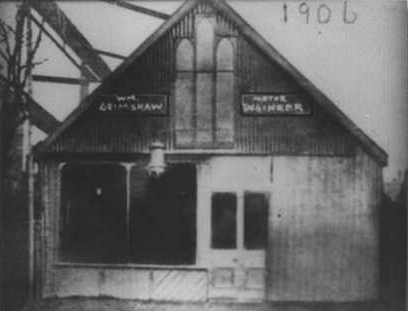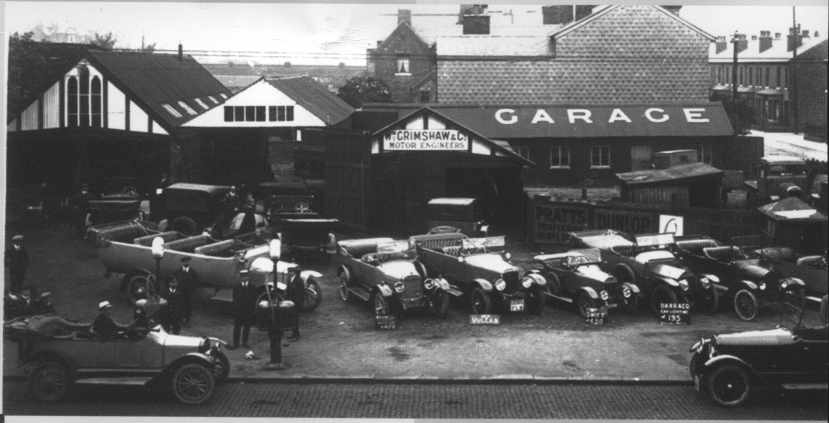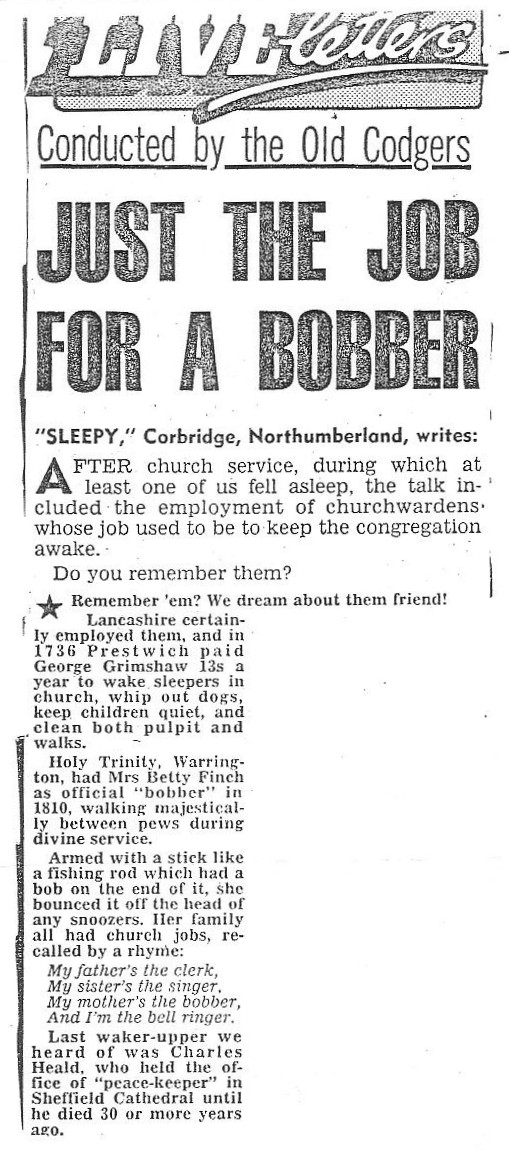Grimshaws in the Prestwich Area
As Described by David Grimshaw, a Descendant

William Grimshaw, “Gramophone King” of parks in the Manchester region, in about 1905
A major line of Grimshaws in Lancashire was established in Prestwich, northwest of Manchester, apparently in the 1600s or earlier. Readily available records indicate that the earliest Grimshaw recorded in Prestwich was a John Grimshaw, who died in 1671. Three Grimshaws — John, James and George — were likely the sons of John and started families in Prestwich in about the same timeframe around 1680. All three are recorded as living on Rooden Lane. John Grimshaw married Alice Crompton, and James Grimshaw married Maria Crompton.
David Grimshaw, a descendant of the Grimshaws in the Prestwich area, has provided a descendant chart that goes back to a George Grimshaw who married Margaret (last name unknown). Their oldest children, Thomas and Job Grimshaw, were born in 1821 and 1824, respectively, so they were probably born in about 1800.
William Grimshaw, David’s great-grandfather, was known as the “Gramophone King” of Heaton Park and other parks in the Manchester region. William played the gramophone in public in about 1909, during the earliest period of commercial sound recording, which drew large crowds of up to 40,000. William owned a bicycle shop when he began selling gramphones. This shop has evolved into the present-day Grimshaws Vauxhall, an auto dealership in Prestwich. Alan Grimshaw, like David Grimshaw, is a descendant of William and is now the managing director of Grimshaws Vauxhall.
Contents
Conjectures on Earliest Grimshaw Family Lines in Prestwich
George and Margaret Grimshaw Descendant Information
Where Is Prestwich in Relation to Manchester?
Background Information on Prestwich from Wikipedia
Photo and Image from David Grimshaw
William Grimshaw, Gramophone King
The Gramophone King as Described in “Surprising Lancashire”
Additional Gramophone King Photos from David Grimshaw
Grimshaws Vauxhall, an Auto Dealership in Prestwich
Interesting Grimshaw Anecdote from the “Daily Mirror”
Is Francis Grimshaw, Apparent Emigrant to America, Descended from the Prestwich Grimshaws?
Edward Grimshaw, Immigrant to America, with Ancestors in Prestwich
Webpage Credits
Thanks go to David Grimshaw for providing the contributions of images and information that have made this webpage possible.
Conjectures on Earliest Grimshaw Family Lines in Prestwich
Records on the LDS FamilySearch and the Prestwich Parish websites have been assembled for the Grimshaw families in the Prestwich area. The websites can be found at:
Parish of Prestwich: http://www.lan-opc.org.uk/Prestwich/
LDS FamilySearch: http://www.familysearch.org/Eng/Search/frameset_search.asp
The assembled records of the earliest Grimshaws in Prestwich are tabulated below; interpretations and conjectures regarding these records are provided below the table.
|
Yr |
Rec |
First Name |
Date |
Spouse |
Additional Information |
Source |
|
1671 |
Bur |
John |
25 Feb 1671 |
LDS | ||
|
1676 |
Mar |
Johanes |
26 Mar 1676
|
Crompton |
Johanes Grimshaw et Alicia Crompton |
PP |
|
1677 |
Mar |
James |
3 Jun 1677 |
Crompton |
James Grimshaw Maria Crompton |
LDS |
|
1681 |
Bur |
Eliz: |
11 Mar 1681
|
Eliz: fa. James Grimshaw de Rooden Lane |
PP | |
|
1682 |
Bap |
Elizabeth |
14 Apr 1682 |
Elizabeth fa. John Grimshaw de Rooden |
PP | |
|
1682 |
Bap |
Mary |
23 Apr 1682 |
Mary fa. George Grimshaw de Rooden |
PP | |
|
1684 |
Bap |
Alice |
11 Jan 1684 |
Alice fa. George Grimshaw |
PP | |
|
1684 |
Bap |
Alice |
8 Mar 1684 |
Alice fa. John Grimshaw |
PP | |
|
1685 |
Mar |
Mary |
9 Aug 1685
|
Hilton |
Andrew Hilton et Mary Grimshaw |
PP |
|
1686 |
Bur |
James |
31 Aug 1686
|
James Grimshaw de Rooden lane |
PP | |
|
1687 |
Bap |
Ann |
23 Oct 1687 |
Ann fa. George Grimshaw |
PP | |
|
1688 |
Bap |
Ann |
29 May 1688 |
Ann fa. John Grimshaw |
PP | |
|
1688 |
Bur |
James |
13 May 1688
|
James f. George Grimshaw |
PP | |
|
1690 |
Bap |
Sarah |
27 Jul 1690 |
Sarah fa. George Grimshaw |
PP | |
|
1691 |
Bap |
William |
14 Apr 1691 |
William f. John Grimshaw |
PP | |
|
1691 |
Bur |
William |
5 Nov 1691
|
William f. John Grimshaw |
PP | |
|
1693 |
Bap |
George |
21 May 1693 |
George f. George Grimshaw |
PP | |
|
1693 |
Bap |
James |
22 Aug 1693 |
James f. John Grimshaw, Whitefield |
PP | |
|
1693 |
Bur |
James |
25 Dec 1693
|
James f. John Grimshaw |
PP | |
|
1696 |
Bap |
Job |
16 Apr 1696 |
Job f. John Grimshaw de Whitefield |
PP | |
|
1697 |
Mar |
Margaret |
20 Apr 1697
|
Heywood |
James Heywood Margaret Grimshaw |
PP |
|
1700 |
Bap |
Phebe |
13 Oct 1700 |
Phebe fa. John Grimshaw |
PP | |
|
1702 |
Mar |
Eliz: |
17 Nov 1702
|
Fallows |
James Fallows Eliz: Grimshaw |
PP |
|
1703 |
Mar |
Mary |
6 Jan 1703
|
Oldham |
Benoni Oldham Mary Grimshaw |
PP |
|
1704 |
Bap |
Alice |
27 Dec 1704 |
Alice fa. John Grimshaw de Whitefield |
PP | |
|
1704 |
Bap |
George |
28 Jan 1704 |
George f. Job Grimshaw de Tatlow |
PP | |
|
1704 |
Mar |
John |
1 Feb 1704
|
Chapman |
John Grimshaw Mary Chapman |
PP |
|
1705 |
Bur |
Anne |
4 Feb 1705
|
Anne fa. Johannis Grimshaw dWhitefield |
PP | |
|
1705 |
Bur |
Alice |
26 Apr 1705
|
Alice uxr John Grimsahaw de Whitefield |
PP | |
|
1707 |
Mar |
Alice |
24 Jun 1707
|
Fallows |
John Fallows Alice Grimshaw |
PP |
|
1707 |
Bur |
Mary |
15 Mar 1707
|
Mary uxor Joannis Grimshaw dRadclif bridge |
PP | |
|
1708 |
Bap |
Henry |
20 Jun 1708 |
Henry s. of Job Grimshaw of Chetham Hill |
PP | |
|
1708 |
Bur |
John |
13 Apr 1708
|
John Grimshaw dWhitefield Innkeeper |
PP | |
|
1709 |
Bap |
Thomas |
24 Aug 1709 |
Thomas s. of Sarah Grimshaw of Rooden lane |
PP | |
|
1709 |
Bur |
George |
12 Apr 1709
|
George Grimshaw of Rooden Lane Sexton |
PP | |
|
1710 |
Bap |
Josiah |
7 Nov 1710 |
Josiah s. of Job Grimshaw of Chetham |
PP | |
|
1711 |
Bap |
Ellin |
14 Nov 1711 |
Ellin d. of John Grimshaw of Radcliffe bridge |
PP | |
|
1711 |
Mar |
Sarah |
4 Dec 1711
|
Eckersley |
Thomas Eckersley Sarah Grimshaw |
PP |
|
1711 |
Bur |
Mary |
18 Jan 1711
|
Mary Grimshaw of Rooden lane widow |
PP | |
|
1712 |
Mar |
Elizabeth |
17 Jun 1712
|
Kay |
Thomas Kay Elizabeth Grimshaw |
PP |
|
1718 |
Bap |
James |
9 Oct 1718 |
Anne Grimshaw & Thomas Scholes |
LDS | |
|
1723 |
Bap |
George |
30 Jan 1723 |
George Grimshaw |
PP | |
|
1723 |
Bur |
Mary |
Apr 1723 |
nonconformist register record |
PP | |
|
1725 |
Mar |
George |
31 Aug 1725 |
Kay |
George Grimshaw Anne Kay |
LDS |
|
1725 |
Bap |
George |
24 Apr 1725 |
George Grimshaw & Sarah |
LDS | |
|
1725 |
Bap |
James |
8 Feb 1725 |
George Grimshaw Y Sarah |
PP | |
|
1745 |
Bap |
John |
15 Apr 1745 |
Mary Grimshaw & Thomas Fallows |
LDS | |
|
1751 |
Mar |
James |
28 May 1751 |
Horsefield |
James Grimshaw Mary Horsefield |
LDS |
|
1752 |
Bap |
James |
21 Jun 1752 |
Mary Grimshaw |
PP | |
|
1756 |
Mar |
George |
4 Feb 1756 |
Holme |
George Grimshaw Betty Holme |
LDS |
|
1756 |
Bap |
James |
31 Mar 1756 |
James Grimshaw & Mary |
LDS | |
|
1758 |
Bap |
George |
9 Mar 1758 |
James Grimshaw & Mary |
LDS | |
|
1759 |
Bap |
George |
11 Mar 1759 |
John Grimshaw & Mgt |
LDS | |
|
1761 |
Bap |
George |
18 Mar 1761 |
John Grimshaw & Mgt |
LDS | |
|
1761 |
Mar |
Martha |
12 Nov 1761 |
Ogden |
Richard Ogden Martha Grimshaw |
PP |
|
1762 |
Mar |
Alice |
29 J7l 1762 |
Farrer |
Charles Farrer Alice Grimshaw |
PP |
|
1765 |
Mar |
George |
19 Feb 1765 |
Darbyshire |
George Grimshaw Lydia Darbyshire |
PP |
|
1766 |
Mar |
James |
24 Jun 1766 |
Hartley |
James Grimshaw Betty Hartley |
PP |
|
1767 |
Bap |
James |
8 Feb 1767 |
James Grimshaw & Betty |
LDS | |
|
1769 |
Mar |
Alice |
23 Oct 1769 |
Royle |
Henry Royle Alice Grimshaw |
PP |
|
1769 |
Mar |
George |
28 Mar 1769 |
Berry |
George Grimshaw Marry Berry |
PP |
|
1769 |
Mar |
Samuel |
12 Sep 1769 |
Bridge |
Samuel Grimshaw Martha Bridge |
PP |
|
1771 |
Mar |
Ann |
5 Nov 1771 |
Collinscock |
James Collinscock Ann Grimshaw |
PP |
|
1772 |
Bap |
George |
22 Mar 1772 |
George Grimshaw & Mary |
LDS | |
|
1773 |
Mar |
Job |
21 Oct 1773 |
Heywood |
Job Grimshaw Ann Heywood |
PP |
|
1774 |
Mar |
John |
15 May 1774 |
Yates |
John Grimshaw Mary Yates |
LDS |
|
1777 |
Bap |
John |
27 Jul 1777 |
John Grimshaw & Mary Yates |
LDS | |
|
1778 |
Mar |
John |
13 Sep 1778 |
Deavers |
John Grimshaw Mary Deavers |
LDS |
|
1787 |
Bap |
James |
30 Aug 1787 |
Nicholas Grimshaw & Susan |
LDS | |
|
1788 |
Mar |
James |
3 Jan 1788 |
Green |
James Grimshaw Martha Green |
LDS |
|
1790 |
Bap |
John |
3 Oct 1790 |
Samuel Grimshaw & Alice |
LDS | |
|
1790 |
Mar |
George |
10 Nov 1790 |
Parr |
George Grimshaw Elizabeth Parr |
LDS |
|
1790 |
Mar |
James |
4 Jan 1790 |
Hardy |
James Grimshaw Mgt Hardy |
LDS |
|
1793 |
Bap |
James |
14 Jul 1793 |
Elizabeth Grimshaw & George Taylor |
LDS | |
|
1793 |
Nup |
George |
29 Sep 1793 |
Samuel Grimshaw & Alice Grimshaw |
PP | |
|
1797 |
Bap |
James |
12 Feb 1797 |
Thomas Grimshaw & Alice Grimshaw |
LDS | |
|
1813 |
Bap |
George |
7 Nov 1813 |
Hugh Grimshaw & Mary |
LDS | |
|
1813 |
Bap |
George |
7 Nov 1813 |
PP | ||
|
1815 |
Bap |
Edward |
9 Jul 1815 |
PP | ||
|
1815 |
Bap |
Esther |
1 Oct 1815 |
PP | ||
|
1817 |
Bap |
Edward |
3 Apr 1817 |
PP | ||
|
1818 |
Bap |
Henry |
5 Apr 1818 |
PP | ||
|
1818 |
Bap |
Mary |
23 Aug 1818 |
PP | ||
|
1819 |
Bap |
Hugh |
17 Oct 1819 |
PP | ||
|
1819 |
Bap |
James |
3 Oct 1819 |
PP | ||
|
1819 |
Bap |
Mary |
31 Jan 1819 |
PP | ||
|
1819 |
Bap |
Mary |
19 Sep 1819 |
PP | ||
|
1820 |
Bap |
John |
3 Sep 1820 |
PP | ||
|
1821 |
Bap |
Hiram |
26 Aug 1821 |
PP | ||
|
1821 |
Bap |
Thomas |
4 Nov 1821 |
PP | ||
|
1822 |
Bap |
Mary Ann |
4 Aug 1822 |
PP | ||
|
1822 |
Bap |
William |
17 Mar 1822 |
PP | ||
|
1823 |
Bap |
Samuel |
3 Aug 1823 |
PP | ||
|
1824 |
Bap |
Ann |
2 May 1824 |
PP | ||
|
1824 |
Bap |
Job |
22 Feb 1824 |
PP | ||
|
1824 |
Bap |
Sarah |
2 May 1824 |
PP | ||
|
1824 |
Bap |
Thomas |
20 Jun 1824 |
PP | ||
|
1825 |
Bap |
Ann |
4 Oct 1825 |
PP | ||
|
1825 |
Bap |
Hugh |
18 Aug 1825 |
PP | ||
|
1826 |
Bap |
Benjamin Brindley |
12 Oct 1826 |
PP | ||
|
1826 |
Bap |
Betty |
1 Jan 1826 |
PP | ||
|
1826 |
Bap |
John |
26 Mar 1826 |
PP | ||
|
1827 |
Bap |
Alice |
26 Jan 1827 |
PP | ||
|
1827 |
Bap |
Ann |
22 Sep 1827 |
PP | ||
|
1827 |
Bap |
Harriot |
26 Jan 1827 |
PP | ||
|
1827 |
Bap |
John |
25 Mar 1827 |
PP | ||
|
1827 |
Bap |
Mary |
16 Dec 1827 |
PP | ||
|
1827 |
Bap |
Sarah Ann |
10 Jun 1827 |
PP | ||
|
1828 |
Bap |
Ann |
8 Feb 1828 |
PP | ||
|
1828 |
Bap |
Ann |
15 Jun 1828 |
PP | ||
|
1828 |
Bap |
George |
19 Oct 1828 |
PP | ||
|
1828 |
Bap |
Sarah |
10 Feb 1828 |
PP | ||
|
1829 |
Bap |
Alice |
12 Jul 1829 |
PP | ||
|
1829 |
Bap |
Charles Cooper |
13 Sep 1829 |
PP | ||
|
1829 |
Bap |
James |
5 Jun 1829 |
PP | ||
|
1830 |
Bap |
John |
25 Apr 1830 |
PP | ||
|
1831 |
Bap |
Elizabeth |
30 Jun 1831 |
PP | ||
|
1831 |
Bap |
George |
24 Jul 1831 |
PP | ||
|
1831 |
Bap |
Hugh |
30 Jun 1831 |
PP | ||
|
1831 |
Bap |
Samuel |
16 Dec 1831 |
PP | ||
|
1832 |
Bap |
Alfred |
16 Sep 1832 |
PP | ||
|
1832 |
Bap |
John |
22 Apr 1832 |
PP | ||
|
1833 |
Bap |
James |
28 Feb 1833 |
PP | ||
|
1834 |
Bap |
Charles |
26 Jan 1834 |
PP |
The above records lend themselves to conjecture on the origins and descendants of the Grimshaws in the Prestwich area.
It is hypothesized that the earliest Grimshaw was a John, who died in Prestwich 1671. He may have descended from the earliest recorded Grimshaw family in Eccleshill (see companion webpage), but he does not apparently show up on the descendant chart by Whitaker2. If he lived from about 1600 to 1671, he would have been a contemporary of the 14th generation descendants of Walter de Grimshaw of Eccleshill (including Thomas, John, Nicholas, Robert, Thomas, Mary, Jane, Margaret, Anne, Elizabeth, Eleanor, and Katherine Grimshaw).
It is further conjectured that this John Grimshaw had three sons – John, James and George – who all lived on or near Rooden Lane in Prestwich. Records indicate that they started their families about the same time, from 1681 to 1682. John apparently married Alice Crompton in 1676, and James married Maria Crompton in 1677, both in Prestwich. It appears that John died in 1708,
James in 1711, and George in 1709. Job Grimshaw may have been another brother, but his family didnt start until some 20 years later, in 1704. So he may have been a son of one of the three brothers, although his birth is not included in the records.
John, James, George and Job Grimshaw all had children; they are summarized below with their dates of baptism (bp) or burial (bur):
John Grimshaw m. Alice Crompton 1676: Elizabeth, bur 1682; Alice, bp 1684; Ann, bp 1688; William, bp 1691 & bur 1691; James, bp 1693; Job, bp 1696; Phoebe, bp 1700; and Alice, bp 1704.
James Grimshaw m. Maria Crompton 1677: Elizabeth, bp 1681; James, bp 1686
George Grimshaw: Mary, bp 1683; Alice, bp 1684; Ann, bp 1687; James, bp 1688; Sarah, bp 1690; and George, bp 1693.
Job Grimshaw, as noted, started his family a bit later: George, bp 1704; Henry, bp 1708, and Josiah, bp 1710. This Job cannot be the one who was the seventh child of John Grimshaw (above), who was born in 1696 – too young to start a family in 1704.
Other records invite further conjecture or observation
James Heywood married Margaret Grimshaw in 1697, who may have been Elizabeth (bp 1682), the daughter of John Grimshaw, or Elizabeth (pb 1681), the daughter of James Grimshaw.
James Fallows also married Elizabeth Grimshaw in 1708, who may have been the Elizabeth not married by James Heywood.
Thomas Kay also married an Elizabeth Grimshaw in 1712.
Thomas Scholes had a son by Ann Grimshaw (James); this Ann may have been the daughter of John (Ann bp 1588) or of George (Ann bp 1687).
Thomas Eckersley married Sarah Grimshaw in 1711, who may have been the daughter (bp 1690) of George Grimshaw. This couple may have had a son, Thomas (bp 1709), a couple of years before their marriage.
George Grimshaw married Anne Kay in 1725; this George (bp 1693) may have been the son of George Grimshaw, one of the three brothers who started the Grimshaw line in Prestwich. George and Anne may have had George Grimshaw (bp 1723) two years before their marriage.
It must be emphasized that the above observations are purely conjectural in the absence of clearer evidence in each case.
George and Margaret Grimshaw Descendant Information
David Grimshaw has provided a very complete and valuable descendant chart for one of the Grimshaw lines of Prestwich, that of George and Elizabeth Grimshaw. An image of the chart, in two parts, is provided below, followed by an alternate form of presentation of the descendant information. George Grimshaw, at the top of the chart, would have been born in about 1800 if his firstborn was born when he was 21 years old. George has not yet been tied into the earlier family lines described in the preceding section.
The above chart is presented in alternate descendant chart format below.
George Grimshaw & Margaret (unknown)
|–2 Thomas Grimshaw (1821 – ?) & Charlotte
|–|–3 unknown son
|–|–3 unknown daughter
|–2 Job Grimshaw (1824 – ?) & Ann Jones. Married 26 Sep 1847, Manchester.
|–|–3 Betty Grimshaw (1855 – ) & Thomas Bleakley
|–|–|–4 Annie Bleakley & Tom Holden
|–|–|–4 Harry Bleakley & Anne
|–|–|–4 Earnest Bleakley
|–|–|–4 George Bleakley & Daisy
|–|–|–4 Arthur Bleakley
|–|–3 William Grimshaw (1859 – 1940) & Ellen Marsh (?- 1941)
|–|–|–4 Wilfred Grimshaw (1885 – ?) & Margaret Alice Jones
|–|–|–|–5 Dorothy Grimshaw (1913 – ) & Leslie Bradshaw
|–|–|–|–|–6 Margaret Lesley Bradshaw (1939 – ?) & Bernard Travis
|–|–|–|–|–|–7 Sarah Travis (1972 – ?)
|–|–|–|–|–6 Arthur Richard Bradshaw (1945 – ?) & Brenda Roberts
|–|–|–|–|–|–7 Jonathan Richard Bradshaw (1971 – ?)
|–|–|–|–|–|–7 Andrew David Bradshaw (1974 – ?)
|–|–|–|–5 Muriel Jones Grimshaw (1922 – ?) & Geoffrey Milburn Wootton (1924 – 1995)
|–|–|–|–|–6 Stephen Milburn Wootton (1951 – ?)
|–|–|–|–|–6 Gillian Margaret Wootton (1956 – ?) & Stephen Carter
|–|–|–|–|–|–7 Melinda Rose Carter
|–|–|–|–|–|–7 Bethany May Carter
|–|–|–|–5 Geoffrey Owen Grimshaw (1925 – ?) & Joan Hutchinson
|–|–|–|–|–6 David Grimshaw* & Ikoomi
|–|–|–|–|–|–7 Naomi Grimshaw
|–|–|–|–|–6 David Grimshaw* & Lynne
|–|–|–|–|–|–7 Tammy Lyn Grimshaw
|–|–|–|–|–|–7 Barbara Ann Grimshaw
|–|–|–4 Harvey Grimshaw (1886 – 1886)
|–|–|–4 Ethel May Grimshaw (1887 – 1968) & William Kay
|–|–|–4 Percy Owen Grimshaw (1891 – 1985) & Sarah Brenda Ashton (? – 1966)
|–|–|–|–5 William Grimshaw (1922 – ?) & Rosemarie Metz (1931 – ?)
|–|–|–|–|–6 Paul William Grimshaw (1955 – ?) & Sandra Riley (1960 – ?)
|–|–|–|–|–|–7 Christopher Riley (1996 – ?)
|–|–|–|–|–|–7 Hayley Maureen Grimshaw (1998 – ?)
|–|–|–|–|–6 Alan James Grimsahw (1958 – ?) & Susan Williams (1958 – ?)
|–|–|–|–|–|–7 Jennifer Grimshaw (1983 – ?)
|–|–|–|–5 Marjorie Patricia Grimshaw (1926 – ?) & Ronald Arthur Barnes (1920 – 1977)
|–|–|–|–|–6 Susan Mary Barnes (1954 – ?) & William Walmsley (1954 – ?)
|–|–|–|–|–|–7 James William Walmseley (1981 – ?)
|–|–|–|–|–6 Pamela Jean Barnes (1955 – ?)
|–|–|–4 Pattie Grimshaw (1895 – ?)
|–|–|–4 Florence Grimshaw (1897 – ?)
|–|–|–4 Doris Grimshaw (1899 – ?) & Norman Roberts
|–|–|–|–5 Shirley Barbara Roberts (1929 – ?) & Derek Smith (1926 – ?)
|–|–|–4 Nellie Grimshaw (1890 – 1890)
|–|–3 Hannah Grimshaw (1867 – ?) & William Herbert Allen (1867 – ?)
|–|–|–4 William Allen (1890 – 1909)
|–|–|–4 Percy Allen (1893 – 1894)
|–|–|–4 Edith Allen & Frank Edwards
|–|–|–|–5 Jean Edwards & Gerald Watts
|–|–|–4 Annie Allen (1907 – ?) & Anthony Regamey
|–|–|–|–5 Joyce Regamey
|–|–|–|–5 Patricia Regamey
|–|–|–|–5 David Regamey Regamey
|–|–|–4 Harold Allen (1908 – 1908)
|–2 Betty Grimshaw (1826 – ?)
|–2 George Grimshaw (1828 – ) & Emma
|–|–3 Lizzie
|–|–3 Samuel
|–2 John Grimshaw & Alice
|–|–3 Clara Grimshaw & Wright Bleakley
|–|–3 James Grimshaw & Violet
|–|–|–4 Stanley
|–|–|–4 Rosie
|–|–|–4 unknown child
|–|–|–4 unknown child
|–2 David Grimshaw & Maria
|–|–3 unknown daughter
|–|–3 unknown son
Where Is Prestwich in Relation to Manchester?
Prestwich is located about five or six km northwest of the center of Manchester, as shown in the maps below.
Background Information on Prestwich from Wikipedia
Prestwich is well described on Wikipedia as shown below. Note the mention of the football fields referenced as “Grimshaw’s” under the section on Sports. David Grimshaw indicated that this land was donated by his grandfather, Wilfred Grimshaw.
Prestwich
From Wikipedia, the free encyclopedia (Source: http://en.wikipedia.org/wiki/Prestwich)
Population 31,693
Prestwich is a town within the Metropolitan Borough of Bury, in Greater Manchester, England. Historically part of Lancashire, the town lies between the neighbouring town of Whitefield and the cities of Manchester and Salford.
As can be seen from the map of 1848,[1] the oldest part of Prestwich developed around what is now, Bury new Road and is known locally as “Prestwich Village”. There is a large Jewish community in Prestwich, bordering with Higher Broughton in Salford to form the second-largest Orthodox Jewish community in the United Kingdom. This is where the Jewish community of Cheetham Hill in Manchester, which no longer exists as such, has fetched up.
Geography and administration
Prestwich was the ecclesiastical centre of Prestwich-cum-Oldham an ancient parish in the Salford Hundred of Lancashire,[2] and became the Prestwich Urban District under the Local Government Act 1894. It was granted a charter to become a municipal borough in 1939. Under the Local Government Act 1972 it became an unparished area in the Metropolitan Borough of Bury, now one of the ten boroughs of Greater Manchester.
Districts of Prestwich include:
Sedgley Park
Rainsough
Brooklands
The nature of Prestwich village changed massively in the 1970s, with the erection of the Longfield Shopping Centre. The construction of the motorways near Prestwich also altered the life and habits of the townspeople. In the 1970s, local government changes brought control of Prestwich under Bury Metropolitan Borough Council. It is somewhat different in character from Bury, however, and looks more towards Manchester and Salford. It is geographically nearer to Salford than to Bury.
Prestwich is bounded on its eastern side by Heaton Park, to the west by the Prestwich Forest Park and the Irwell Valley (Agecroft) and to the south by the City of Salford. The two main north-south roads passing from central Manchester to Bury, Bury New Road (A56) and Bury Old Road, traverse the district, .
History
Etymology
The name Prestwich is possibly of Saxon origin, derived from Priest Wic, which in Saxon translates to the priest’s farmed land. Another possible derivation of the town’s name is Priest’s Retreat, one of the village bars is named after this. Wich and wych are names used to denote brine springs or wells in England. Originally derived from the Latin vicus (place) by the 11th century, use of the ‘wich’ suffix in placenames was usually associated with towns involved with salt production.[3]
Economics
Prestwich is a self-contained community with a wide range of traditional and superstore shopping. The shops of the Jewish community in Prestwich give it a particular distinction.[4]
Demographics
There is an area of south Prestwich which is known as Sedgley Park. This area has a sizeable Jewish population, and there are many Jewish businesses, specialist shops and delicatessens along King’s Road, Bury New Road and Bury old Road.
There is also a large Irish Catholic community in Prestwich and the surrounding area, served by St Monica’s RC High School Specialist Language College located alongside Bury Old Road and Our Lady of Grace Primary School on Willow Road.
Religion and History
Bury New Road, which runs through the centre of Prestwich, roughly follows the line of a Roman road connecting Manchester to Longridge. It is believed that a Roman fort was built in Prestwich. Although its precise location is unknown it is thought that it may have been in the Castle Hill area, mirroring the fort on Rainsough Hill equidistant from the Roman Road. Roman coins have been found in Prestwich. Most have been found just off Bury New Road and near Prestwich Golf Course, however some have been found in Prestwich Clough about half a mile away from Prestwich village and Bury New Road.
The early history of Prestwich is inextricably linked with the church. Prestwich itself has very ancient origins, and at least for the early parts of its history, the fortunes of the village seem to have followed the fortunes of its parish church. It is known that a Rector of Prestwich existed by at least 1200. The present large parish church, at the end of Church Lane in the village centre, is dedicated to St Mary the Virgin and parts of it date from around 1500, although the last extensions were made at the end of the 19th century. It was the centre of the vast ancient ecclesiastical parish of Prestwich-cum-Oldham. For a time in the 19th century, the church was referred to locally as St Bartholomew’s, which could be attributed either to the unpopularity of the Blessed Virgin at the time, or to sheer ignorance. The Church Wakes were traditionally held around St Bartholomew’s Day, and this could have reinforced the error.
In 1849, St Margaret’s Church was erected near the gates of Heaton Park, originally as a chapel of ease to the parish church, but since 1885 as a parish church in its own right. The church was extended many times in the 19th cenutry, in 1863, 1871, 1884, 1888 and 1899. A particular feature of St Margaret’s Church, is the splendid Arts and Crafts Movement oak carving (including reredos, choir stalls, rood screen, panelling, pulpit, bishop’s chair, altar rails, etc.) by Arthur Simpson of Kendal, widely believed to be the finest collection of his ecclesiastical work.
Other Anglican churches in the area include churches dedicated to St Gabriel, St Hilda, and St George.
The Roman Catholic Church in Prestwich began to reappear in late Victorian times. Mass was celebrated in 1889 for the first time since the Reformation. The present Catholic church, dedicated to Our Lady of Grace, was opened in 1931 and consecrated in 1956. There are two local Methodist churches, Heaton Park Methodist Church and Prestwich Methodist Church.
In more recent times, the migration of Jewish families, mainly from Cheetham area of Manchester and Broughton Park in Salford, and later arrival of Muslims into this thriving urban area of Greater Manchester, resulted in the additional presence of synagogues and mosques, alongside Christian places of worship.
Places of interest
Heaton Park
Europe’s largest municipal park at 259 hectares (640 acres), Heaton Park, is situated to the east of Prestwich, within the City of Manchester. This was the ancient seat of the Earls of Wilton but was sold to Manchester Corporation in 1902. The park is 4 miles from Manchester city centre and although officially part of the City of Manchester, has a Prestwich postal address.[5]
Prestwich
Forest ParkPrestwich Forest Park consists of 200 hectares of land on the western side of Prestwich incorporating:
Philips Park
Prestwich Clough
Mere Clough
Waterdale Meadow
Drinkwater Park
While much of the area of the present park was industrialised during the eighteenth and nineteenth centuries it has mostly now been returned to a more natural state with extensive woodlands, reservoirs and grasslands. While this area has become a haven for wildlife there are still remnants to be found of the area’s industrial past. Philips Park, Prestwich Clough and Waterdale Meadow are described in excellent downloadable illustrated leaflets produced by the Metropolitan Borough of Bury Environmental Services Department describing the history, wildlife and points of interest.[6][7] Drinkwater Park is described in a separate Wikipedia article. Philips park has been designated as a Local Nature Reserve (LNR) and Prestwich Clough as s Site of Biological Importance (SBI) due to the important contribution they make to the wildlife heritage of Greater Manchester. The Irwell Valley Sculpture Trail, The Irwell valley Way and a National Cycle Route all pass through the Park. The Friends of Prestwich Forest Park and the British Trust for Conservation Volunteers (BTCV) coordinate volunteer activities and events such as the Prestwich Clough Centenary Celebrations.[8][9] The BTCV have a permanent base in the renovated Philips Park Barn which has become a major environmental education and countryside centre for the borough.[10]
Sport
Football
The local amateur team which represents Prestwich is Prestwich Heys FC. For many years, Prestwich Heys played on the fields just off Heys Road, a site known as Grimshaw’s. The local high school, Prestwich High School as was (now the Arts College), obtained the land for use as their sports fields and Prestwich found a new home on Sandgate Road, just over the border in Whitefield. This field was near the site of the old St Joseph’s RC High School (which merged with St Peter’s RC High School, rebadged itself as St Monica’s RC High School and located itself on the St Peter’s site) and has been redeveloped to include enclosed concrete “fencing”, a car park and club facilities. Prestwich Heys currently play in the Manchester Football League. Other local sides include Bury Amateurs who play their home games at Drinkwater Park, Rainsough and also Prestwich Marauders who have various places where they play their home matches. These teams are usually in the North Bury League or the Bury and Radcliffe League.
Cricket
The main cricket club in Prestwich is Prestwich Cricket Club, which has been very successful over recent years. Located between Prestwich Metrolink station and the Grimshaw’s playing fields mentioned earlier, Prestwich CC also has crown green bowling and tennis facilities as well as a spacious clubhouse. Prestwich CC has been on this site for many years, with the clubhouse having many photos on display from previous teams and players.
References
http://web.archive.org/web/20081121144552/http://www.old-maps.co.uk/IndexMapPage2.aspx
http://www.mancuniensis.info/Maps/salfh_xs.pdf
retrieved 2007-11-02Domesday Book
http://www.rochdaleobserver.co.uk/about/s/0/49_prestwich_advertiser.html
http://www.manchestergalleries.org/our-other-venues/heaton-hall/visitor-information/
Retrieved 2007-10-26http://www.bury.gov.uk/NR/rdonlyres/519FF1DD-000A-4F50-A3CB-245980F3B067/0/PhilipsParkLNR.pdf
Retrieved 2007-10-26http://www.bury.gov.uk/NR/rdonlyres/9ECF59AA-5F75-43E6-8114-65EF644F3ADD/0/PrestwichClough.pdf
Retrieved 2007-10-26http://upcoming.yahoo.com/event/176936/
Retrieved 2007-10-26Home Pagehttp://web.archive.org/web/20090429105219/http://www.bury.gov.uk:80/Environment/Planning/PlanningProjects/CountrysideAndWildlife/PrestwichFP.htm
Retrieved 2007-10-26http://prestwichsnooker.com/index.php?s=8cf8066c1bc492705027a4a9df29e52f&act=idx
http://www.manchestereveningnews.co.uk/news/showbiz/s/216/216494_victoria_wood_to_return_to_drama.html
Montagu Lomax, The Experiences of an Asylum Doctor London: George Allen & Unwin 1921
BA Towers The management and politics of a public expose: the Prestwich Inquiry 1922 J Social Policy (1984) 13: 41-61
TW Harding, “Not worth powder and shot.” A reappraisal of Montagu Lomax’s contribution to mental health reform British Journal of Psychiatry (1990) 156: 180-187
Hopton Daily life in a 20th century psychiatric hospital: an oral history of Prestwich Hospital Int Hist Nurs J (1997) 2: 27-39
Hopton Prestwich Hospital in the twentieth century: a case study of slow and uneven progress in the development of psychiatric care History of Psychiatry (1999) 10: 349-369
Photo and Image from David Grimshaw
David initiated this webpage by providing the two images below. The first is a photo of Grimshaws Vauxhall many years ago. The second is an image of a flier for William Grimshaw, “Gramophone King”. Both of these images are described further down on this webpage.
William Grimshaw, Gramophone King
William Grimshaw owned a bicycle shop and began selling gramophones in the late 1800s or early 1900s. Apparently in connection with his promoting the new machine, William played the gramophone in public, which proved immensely popular for a period of time, drawing as many as 40,000 at Heaton Park. The following article is from the BBC online.
If you took your stereo down to Heaton Park, how many people would turn up to listen? Almost a century before the BBC Proms in The Park, a Manchester gramophone salesman drew a crowd of 40,000 – playing his record collection!
BBC Proms in the Park takes place on Saturday with 15,000 people expected to turn out to watch the BBC Philharmonic perform live on stage in Heaton Park. The finale to the evening, will be a live link up with the Last Night of the Proms
in the Royal Albert Hall for a flag-waving patriotic sing-along.Its the first time the Proms event has gone urban – and been staged in a city venue. But Heaton Park has a tradition of playing classical music to the masses which dates back almost a century…
Gramophone King: William Grimshaw
That tradition was started early last century by William Grimshaw from Prestwich. Grimshaw originally sold bicycles from his shop on Bury New Rd but expanded his trade to include the new invention of the day – the gramophone.
In 1909, William Grimshaw listened to the great Italian tenor Enrico Caruso perform at the Free Trade Hall. He wanted to share this experience with the ordinary people of Manchester so, a few days later, he took his gramophone to Heaton Park and played recordings of Caruso to an assembled crowd of 40,000 people!
“He always liked the public and I think that was why: because he wanted to bring pleasure, to bring music to people who werent able to afford it”
Susan Cahal
Local papers such as the Manchester Evening Chronicle and the Crumpsall Guardian reported that the trams from Manchester and Bury were unable to cope with the huge numbers of concert-goers.
An extract from the Sound Wave and Talking Machine Record, printed in December 1909 reports the occasion as follows:
“In the course of his tour of the provinces, Signor Carusos engagements took him to Manchester on September 13 and with his usual enterprise, Mr Grimshaw gave a Gramophone concert in Heaton Park on the following Sunday embracing all the items sung by Caruso A vast crowd, estimated to number at least 40,000 assembled to hear the Gramophone.”
Caruso himself wrote to Mr Grimshaw expressing his thanks and appreciation of the way his voice had been reproduced. He even sent Grimshaw a signed cartoon of himself! (see below)
Caruso: by Caruso
Photographs show crowds dressed formally in Edwardian suits and dresses, wearing caps and hats all listening attentively. Indeed, in the words of the Prestwich and Heaton Park Guardian
“
they remained as if spellbound from the moment of arrival to the close of the programme, which, it is hardly necessary to say, was intensely enjoyed.”Grimshaw was the first man in England to give gramophone concerts in the open and the idea spread rapidly around the country. He was soon contracted by Manchester Corporation to hold them in Heaton Park for several seasons and the popularity of these events grew and grew.
In effect, he was the very first club DJ in the world. And for his tour bus? He used a Prestwich Co-op horse-drawn milk cart to transport his equipment to the Park.
William Grimshaws great-granddaughter is Susan Cahal who lives in Radcliffe. She says his concerts were so popular he became known across Lancashire as the Gramophone King.
“He always liked the public and I can only imagine that was why: because he wanted to bring pleasure, to bring music to people who werent able to afford machines in the home.
A poster of one of Grimshaw’s concerts
“In 1907, he told the Manchester Corporation that an extra large horn would enable large crowds of people who couldnt afford equipment of their own to hear music in the open air which was becoming available on records.”
She added: “As things were at the time, they didnt have the same publicity to advertise events, and I think it was absolutely wonderful and very far seeing.”
Far seeing indeed. Almost 100 years later, Heaton Park will be filled with the sounds of classical music again thanks to Proms in the Park. Grimshaw, I think, would approve.
last updated: 09/09/05
The Gramophone King as Described in “Surprising Lancashire”
David Grimshaw provided the following image of a chapter from “Surprising Lancashire1“, which is on the history of Lancashire.
This chapter provides additional detail on William Grimshaw’s success in playing the gramophone for the public early in the 20th century.
Additional Gramophone King Photos from David Grimshaw
In March 2013 David Grimshaw provided an excellent picture of William Grimshaw with his gramphone, which is shown below. It is an excellent version of the photo shown above.
David also sent several photos of a park where a gramophone performance was underway. The photo shown below was chosen for this webpage because it clearly shows the gramophone near the center of the photo along with the sizeable crowd that turned out for the performance.
Shown below is an image of a second handbill provided by David Grimshaw (in addition to the one shown above on this webpage).
Grimshaws Vauxhall, an Auto Dealership in Prestwich
William Grimshaw’s bicycle evolved over time to the current auto dealership, Grimshaws Vauxhall. The dealership website can be visited by clicking here. The website is summarized below, followed by a brief description of the Vauxhall Automotive Company, which is owned by General Motors of the USA. Note the brief statement and signature of Alan Grimshaw, great-grandson of William Grimshaw.
Welcome to Grimshaws Vauxhall
Our business is built on personal relationships. That is as true now as it was in 1882 when my great grandfather established the first enterprise to carry the Grimshaws name. Much has changed in the intervening years but, as we are about to celebrate our 125th year in business the people we are proud to call both clients and friends are still our paramount concern.

MANAGING DIRECTOR
GRIMSHAWS VAUXHALL PRESTWICH Bury New Road, Prestwich, Manchester. M25 3BD
Background InformationVauxhall Motors Limited
Vauxhall Motors

From Wikipedia, the free encyclopedia (Source: http://en.wikipedia.org/wiki/Vauxhall_Motors)
Vauxhall Motors Limited
Type Private (subsidiary of General Motors since 1925)
Founded 1903
Headquarters Luton, Bedfordshire, England
Revenue £3,785 million (2004)
Operating income £131 million (2004)[1]
Net income £-176 million (2004) [1]
Employees 5,047 (2004)[1]
Parent General Motors Corporation
Website www.vauxhall.co.uk
Vauxhall Motors is a UK car company. It is a subsidiary of General Motors. Most current Vauxhall models are right-hand drive derivatives of GM’s Opel brand with several performance vehicles coming from Holden/Holden Special Vehicles in Australia and Lotus Cars of Norfolk, England (owned by Malaysia’s Proton).
History
Alexander Wilson founded the company in Vauxhall, London in 1857. Originally named Alex Wilson and Company, then Vauxhall Iron Works, the company built pumps and marine engines. In 1903, the company built its first car, a five-horsepower model steered using a tiller, with two forward gears and no reverse gear. This led to a better design which was made available for sale.
To expand its production, the company moved the majority of its production to Luton in 1905. The company continued to trade under the name Vauxhall Iron Works until 1907, when the modern name of Vauxhall Motors was adapted. The company was characterised by its sporting models, but after World War I, designed more austere models.
GM purchase
In 1925, Vauxhall was bought by GM for US$2.5 million. The influence of the American parent was pervasive and together with the Ford Motor Company, Vauxhall’s main competitor, led to a wave of American influenced styling in Europe that persisted through to the 1980s. Bedford Vehicles, a subsidiary constructing commercial vehicles, was established in 1930 as the Stock Market Crash of 1929 had made importing American lorries uneconomical.
During World War II, car production was suspended to allow Vauxhall to work on the Churchill tank, which was designed at Luton in less than a year, and assembled there (as well as at other sites). Over 5,600 Churchill tanks were built.
Post World War II
After the war, car production resumed but models were designed as a more mass-market product leading to expansion of the company. A manufacturing plant at Ellesmere Port was built in 1960. During the 1960s Vauxhall acquired a reputation for making rust-prone models, though in this respect most manufacturers were equally bad. The corrosion protection built into models was tightened up significantly, but the reputation dogged the company until the early 1980s.
By the late 1960s, the company was achieving five-figure sales on its most popular models including the entry-level Viva and larger Victor.
21st Century
The first years of the 21st century saw Vauxhall further strengthen its position in the British market, and continue to narrow the gap with Ford. The Corsa was regenerated in 2000 and offered a better-handling, better-built and better-equipped package than ever before.
2002 was one of the best years ever for Vauxhall sales in the UK. The updated Corsa (launched in 2000) was Britain’s second most popular new car, and gave the marque top spot in the British supermini car sales charts for the very first time. The Astra was Britain’s third best selling car that year, while the Vectra and the Zafira (a clever Compact MPV launched in 1999) lurked just outside the top ten with relatively strong sales.
Closures and restructuring
Vauxhall announced that the Luton car plant would close in 2000, with the final vehicle being made in March 2003, but production still continues at the plant in Ellesmere Port. Manufacture of vans (sold under the Vauxhall, Opel and in some cases Renault) badges throughout Europe) continues at the IBC Vehicles plant in Luton.
On 17 May 2006 Vauxhall announced the loss of 900 jobs from Ellesmere Port’s 3,000 staff. Despite already meeting efficiency targets Vauxhall has been told to further improve productivity. Vauxhall’s troubled parent GM is cutting 30,000 jobs in the United States. [1]
Origins of the name and the logo
The griffin emblem, which is still in use, is derived from the coat of arms of Fulk le Breant, a mercenary soldier who was granted the Manor of Luton for services to King John in the thirteenth century. By marriage, he also gained the rights to an area near London, south of the Thames. The house he built, Fulk’s Hall, became known in time as Vauxhall. Vauxhall Iron Works adopted this emblem from the coat of arms to emphasise its links to the local area. When Vauxhall Iron Works moved to Luton in 1905, the griffin emblem coincidentally returned to its ancestral home.
The logo (as pictured) used to be square however now, it is circular.
David Grimshaw has provided the two photos below of Wm Grimshaw’s garage in 1910 and a later photo as well. The second photo is the same as the one above from the car dealership website.
Interesting Grimshaw Anecdote from the “Daily Mirror”
An interesting article on parishioners charged with keeping church attendees awake and alert was published in the Daily Mirror on 11/12/1986. It mentions a George Grimshaw, who was paid 13s in 1786 for performing this valuable function as well as being responsible to “whip out dogs, keep children quiet, and clean both pulpit and walks.” This George could be the one described in the preceding section but it is unlikely. If he was just 21 in 1786, he would have been 56 years old when his first child was born in 1821.
Is Francis Grimshaw, Apparent Emigrant to America, Descended from the Prestwich Grimshaws?
American immigrant Francis Bowker Grimshaw (see companionwebpage) was apparently born in Cheetham, which is located close to Prestwich. Based only on geographic proximity at this time, it is hypothesized that Francis’ apparent father, Richard D Grimshaw, and grandmother, Mary Grimshaw, were descended from one of the Prestwich Grimshaw lines.
Edward Grimshaw, Immigrant to America, with Ancestors in Prestwich
Edward Grimshaw, and immigrant to Vermont in the United States, is a seventh generation descendant of a Grimshaw family line in Prestwich (see companion webpage). Edward’s ancestry and descendant chart is shown below with Edward indicated in bold and italic font. Edward’s earliest ancestor, James Grimshaw (married Elizabeth Guest) has apparently not yet been connected to other identified Prestwich Grimshaw lines.
James Grimshaw (bef 1613 – 1886, Rooden Lane) & Elizabeth Guest* (1644, Prestwich – 1674, Prestwich). Married 11 Sep 1638, St Marys Prestwick
|—1James Grimshaw (1618 – 1660)
|—1George Grimshaw (? – 1709, Rooden Lane) & Maria Rollinson (1654, Prestwich – 1711, Rooden Lane). Married 30 Oct 1673, St Marys Prestwich.
|—|—2 Job Grimshaw (1674 – ?)
|—|—2 James Grimshaw (1676 – 1688)
|—|—2 Elizabeth Grimshaw (1679 – ?)
|—|—2 Mary Grimshaw (1682 – ?)
|—|—2 Alice Grimshaw (1683 – ?)
|—|—2 Ann Grimshaw (1687 – ?)
|—|—2 Sarah Grimshaw (1690 – 1758)
|—|—2 George Grimshaw (1683, Prestwich – 1761, Prestwich) & Sarah Wild (? – 1750, Hardmans Fold). Married 17 Aug 1725, St Marys Prestwich.
|—|—|—3 James Grimshaw (1725 – 1809)
|—|—|—3 John Grimshaw (1728 – ?)
|—|—|—3 Samuel Grimshaw (1730 – ?)
|—|—|—3 Mary Grimshaw (1733 – ?)
|—|—|—3 Martina Grimshaw (1736 – ?)
|—|—|—3 George Grimshaw (1739, Prestwich – 7 Sep 1813, Prestwich) & Lydia Dargyshire (? – bur 29 Nov 1765). Married 19 Feb 1765, St Marys Prestwich.
|—|—|—3 George Grimshaw (1739, Prestwich – 7 Sep 1813, Prestwich) & Mary Berry (1743 – 15 Aug 1827, Prestwich). Married 28 Mar 1769, St Marys Prestwich.
|—|—|—|—4 Richard Grimshaw (1770 – 1828)
|—|—|—|—4 George Grimshaw (1772 – 1791)
|—|—|—|—4 Samuel Grimshaw (1774 – 1831)
|—|—|—|—4 John Grimshaw (1777 – 1779)
|—|—|—|—4 Sarah Grimshaw (1779 – 1783)
|—|—|—|—4 William Grimshaw (1782 – ?)
|—|—|—|—4 Hugh Grimshaw (1786, Prestwich – 1836, Prestwich) & Mary Maddocks (1789 – 1835, Prestwich). Married 17 Jul 1808, St Marys Prestwich.
|—|—|—|—|—5 Jane Grimshaw (1809 – ?)
|—|—|—|—|—5 Ralph Grimshaw (1810 – 1835)
|—|—|—|—|—5 Ellen Grimshaw (1812 – ?)
|—|—|—|—|—5 George Grimshaw (1813 – 1836)
|—|—|—|—|—5 Edward Grimshaw (1815 – 1816)
|—|—|—|—|—5 Edward Grimshaw (1817 – 1836)
|—|—|—|—|—5 John Grimshaw (26 Jul 1820, Prestwich – 1863, Prestwich) & Sarah Walker (1827, Great Heaton – 1902, Prestwich). Married 5 Apr 1853, St Marys Prestwich.
|—|—|—|—|—|—6 Hugh Grimshaw (1854 – 1861)
|—|—|—|—|—|—6 Edward Grimshaw (24 Apr 1857, Prestwich – 27 Dec 1924, Hartford, CT) & Mary Ann Heywood (Oct 1858, England – ?). Married 9 or 13 Oct 1881, Oldham, Lancashire.
|—|—|—|—|—|—|—7 Hugh Edward Grimshaw (1882 or 15 Oct 1888, Prestwich – 18 Jul 1947, Rutland, VT) & Frances Gates Stockwell (Nov 1891, Vermont – ?). Married 1 Feb 1913, Cavendish, Vermont.
|—|—|—|—|—|—|—|—8 Helen Mary Grimshaw (3 Oct 1914, Ludlow, VT – 29 Dec 1999, Springfield, VT) & David A Rock. Married 25 May 1946, Ludlow, VT
|—|—|—|—|—|—|—|—8 Norman Stockwell Grimshaw (5 Mar 1919, Ludlow, VT – 20 Aug 2012, Rutland, VT) & Patricia M Gertisser or Mulcahy. Married 16 Sep 1946, Rutland, VT.
|—|—|—|—|—|—|—7 Walter Grimshaw (1884 – ?)
|—|—|—|—|—|—|—7 Sarah H or Ellen Grimshaw (1887 – ?)
|—|—|—|—|—|—|—7 May Grimshaw (1889 – ?)
|—|—|—|—|—|—|—7 Ada Mary Grimshaw (15 Sep 1892 – 22 Jul 1978)
|—|—|—|—|—|—|—7 Clara Grimshaw (1896 1977)
|—|—|—|—|—|—6 George Grimshaw (1859 – ?)
|—|—|—|—|—|—6 John Grimshaw (1863 – ?)
|—|—|—|—|—5 Mary Ann Grimshaw (1822 – 1839)
|—|—|—|—|—5 Hugh Grimshaw (1824 – 1825)
|—|—|—|—|—5 Benjamin Brindley Grimshaw (1826 1827)
|—|—|—|—|—5 Sarah Grimshaw (1828 – ?)
|—|—|—3 Sarah Grimshaw (1742 – ?)
|—|—|—3 Job Grimshaw (1744 – ?)
|—1 J ob Grimshaw (1639 – ?)
|—1 Elizabeth Grimshaw (1640 – 1653)
|—1 James Grimshaw (1643 – 1649)
|—1 James Grimshaw 1650 – 1653)
|—1 Nathan Grimshaw (1652 – 1654)
|—1 Elizabeth Grimshaw (1656 – 1681)
|—1 Ann Grimshaw (1658 – ?)
*Parents of Elizabeth Guest were Job Guest (1590 – 1660) & Margery Bullowe (1590 – ?)
Soruces: SPC Family Tree, Hodge Family Tree,
References
1Aspin, Chris, 1988, Surprising Lancashire: Accrington, Helmshore Local History Society, Printed by Caxton Printing Co.
2Whitaker, Thomas Dunham, 1872, An History of the Original Parish of Whalley, and Honor of Clitheroe (Revised and enlarged by John G. Nichols and Ponsonby A. Lyons): London, George Routledge and Sons, 4th Edition; v. I, 362 p.; v. II, 622 p. Earlier editions were published in 1800, 1806, and 1825.
Webpage History
Webpage posted December 2007. Upgraded April 2013 with reorganization and addition of two photos related to William Grimshaw, “Gramophone King”. Also with addition of Edward Grimshaw, immigrant to Vermont, with ancestors in Prestwich.
